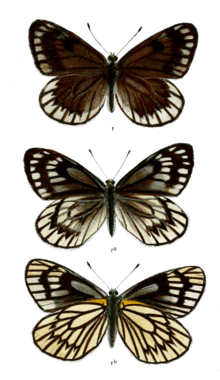Aporia nabellica
| Dusky Blackvein | |
|---|---|
 | |
| Scientific classification | |
| Kingdom: | Animalia |
| Phylum: | Arthropoda |
| Class: | Insecta |
| Order: | Lepidoptera |
| Family: | Pieridae |
| Genus: | Aporia |
| Species: | A. nabellica |
| Binomial name | |
| Aporia nabellica (Boisduval, 1836) | |
Dusky Blackvein (Aporia nabellica) is a midsized to large butterfly of the Family Pieridae, that is, the Yellows and Whites, which is found in India and Pakistan in the W. Himalayas: Kashmir to Naini Tal from 2,600 to 4,000 m (8,500 to 13,000 ft). It has a wing expanse of 6 to 7 cm.
Description
- See glossary for terms used
Males and females have the upperside white, with the veins more or less black, but the ground-colour in many specimens are so densely overlaid by black scales over nearly the whole surface of both fore and hind wings as to leave only a subterminal series of more or less rectangular spots of the white ground-colour apparent on each wing, those on the hind wing are the largest and are inwardly acutely emarginate. In addition, there is a large ill-defined black patch on the discocellulars of the fore wing and a small spot of the same colour generally on the discocellulars of the hind wing. Cilia of both wings black. In nearly all specimens the discoidal cells of the wings are greyish, and on the fore wing there are anterior discal, elongate, greyish spots beyond the apex of the discoidal cell. A few specimens, generally females, are much lighter in colour. In these the irroration of black scales is sparse and allows much of the white ground-colour to show through; the discocellulars of the fore wing, however, are marked by a large black patch as in the darker individuals; and both fore and hind wings bear postdiscal, irregular, transverse black bands; that on the tore wing bisinuate, sometimes not extended below vein 2; that on the hind wing not reaching the dorsal margin, curved, and formed of somewhat ill-defined, irregular, conjoined, outwardly acute, arrow-shaped black spots. Underside: white, the veins on both wings very broadly black-edged; apex of fore wing very slightly, the whole surface of the hind wing more strongly suffused with yellow; the fore wing sometimes clouded posteriorly with black scaling; both fore and hind wings with postdiscal transverse black bands as on the upperside but broader; the base of the hind wing above vein 8 chrome-yellow. Antennae black, the club ochraceous at apex; head and thorax clothed with fine dusky greyish-black hairs; abdomen black above, beneath greyish white.[1]
References
- ↑ Bingham, C. T. (1907). Fauna of British India. Butterflies. Vol 2.